| Jelbic people Jelb'koékai | |
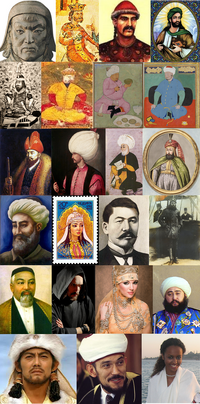 A selection of notable Jelbics | |
| Total population | |
| approx. 150 million | |
| Regions with significant populations | |
| 100–105 million | |
| 15–16 million | |
| 14–15 million | |
| 4–5 million | |
| 2–3 million | |
| 2–3 million | |
| 1–2 million | |
| 250,000–350,000 | |
| Languages | |
| Old High Jelbic, Jelbek, Brmek, Pntek, Wrnukaek, Banmek, Vanukeaans, Classical Brmek, Jelbido | |
| Religions | |
| Ahmadism, Hosianism, Felinism, Tanhrism, Zollism | |
| Related ethnic groups | |
| Turjak people, Dissuwan people, Mu-Tze, Bianjie people, Gao-Showa people | |
The Jelbic people (Old High Jelbic: Jelb'koékai) or Jelbics are a major meta-ethnicity whose members live predominantly in North-West Majatra and speak the Jelbic languages, a group of mutually intelligible dialects descending from Old High Jelbic. Jelbics share, to varying degrees, linguistic, cultural, political, ethnic, and historical traits, in addition to numerous indigenous elements. The Jelbic people are thus a broad and heterogeneous ethno-linguistic group of peoples. For that reason Jelbic identity is primarily based on linguistic grounds, however not all native Jelbic speakers consider themselves Jelbic, and many non-speakers (most notably the Vanukean people) have adopted a Jelbic identity.
Jelbic peoples are divided into four main ethnic groups, namely the Jelbek, Brmek, Wrnukaek, and Pntek who form substantial populations in Jelbania, Barmenistan, Vanuku, and Pontesi, respectively, collectively known as the "Jelbosphere". Other smaller Jelbic groups, such as the Dztek or Jelbido, are found as minorities in several other nations.
History[]
Early history[]
Jelbic languages belong to the Jelbo-Tukaric language family, one of Terra's primary language families, with speakers covering a vast and diverse geographic area, from Bianjie in Dovani to North-West Majatra. Substantial populations speaking Jelbo-Tukaric languages are found on every continent except Artania and Makon. The current location of the Jelbic populations must therefore be seen through the prism of the worldwide expansion of the Jelbo-Tukaric language family, an ancient phenomenon known in scholarly literature as the Jelbo-Tukaric expansions.
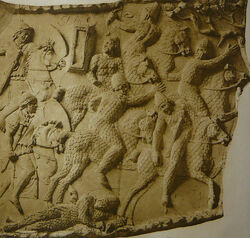
Ancient Cildanian depiction of Jelbo-Tukaric horsemen, celebrating Cildanian victory in the Battle of Alazinder River (39 BCE)
The expansions consisted of a number of partially-related events whereby Jelbo-Tukaric-speaking tribes spread from their original homeland somewhere in Central Seleya towards North and South Seleya, Dovani, and Majatra, in several distinct waves between the 2nd century BCE and the 8th century CE. In Majatra the expansion was manifested in the Jelbo-Tukaric Migrations, during which a collection of tribes successfully invaded, occupied, and settled in territories controlled by the collapsing Cildanian Hegemony. The initial Jelbo-Tukaric speaking tribes were a genetically diverse group of people united by shared cultural norms and languages, which they brought with them to their new homeland. Diffusion of these cultures and languages took place by patron-client systems, which allowed for the absorption and cultural assimilation of the conquered peoples and the spread of the Jelbo-Tukaric languages. The Jelbo-Tukaric Migrations had a major linguistic impact on Majatra, as in their aftermath vast areas of the continent gradually adopted the languages and cultures of the invading tribes. Thus the roots of the establishment of the Jelbic homeland in North-West Majatra lay in this historical phenomenon, but, although the invasions ultimately led to the fall of the Cildanian Empire, it would take centuries for the Jelbo-Tukaric tribes to settle in all former Cildanian and Selucian territories on the continent.
The initial Jelbo-Tukaric tribes spoke a number of closely-related languages, but owing to their sparse attestation very little is known about them. It can be hypothesized that proto-Jelbic, the ultimate ancestor of all Jelbic languages, diverged from the other Jelbo-Tukaric languages in Majatra sometime around the 2nd century. The most probable Urheimat of proto-Jelbic is the Perimor Steppe, the only area in Majatra where the invading Jelbo-Tukarics settled in large numbers. From here the proto-Jelbics continued their northward migration, subduing the various tribes and kingdoms that stood in their path. By the time of the conquests of Augustus the Great, identifiably Jelbic-speaking tribes ruled over an area stretching from Pontesi in the north to the Perimor Steppe in Jelbania. The rapid expansion of the Leucopolitan Empire under Augustus brought many proto-Jelbics under Enetric rule, including parts of the Steppe, but most Jelbic tribes remained outside the area of Augustan rule. Another event that impacted the early Jelbics and eventually led to the crystallization of the first centralized Jelbic polities was the Deltarian Migration, during which Deltarian tribes migrated from Artania to their eventual homeland in Central Majatra, moving through Jelbic areas and temporarily subduing Jelbic tribes.
First Khanates[]
The power vacuum produced by the weakening of the Augustan Empire by the Deltarian land-taking allowed for the establishment of the first major Jelbic khanates. In the Perimor Steppe Grzkai 'One Eye' took advantage of the Augustan-Deltarian conflict by unifying the Jelbic tribes in the Steppe and created the First Jelbek Khanate, while in Vanuku Merlkai the Conqueror successfully resisted Augustan expansion into formerly Deltarian-ruled Jelbic lands, establishing the Khanate of the Banster. These first Jelbic khanates formed the basis of later iterations of Jelbic culture and play a central role in the national narratives of the Jelbic peoples. However in most areas outside Perimor the Jelbic-speakers were in the minority, forming a ruling elite while most of the population spoke Qedarite and Enetric languages. This would change in the 13th century with the founding of Ahmadism and the establishment of the first Caliphate.
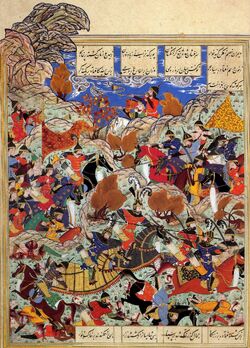
Barmenian miniature depicting the Battle of Vrkzel, one of the early Caliphate's most important victories
Ahmadism[]
In the north, an area outside core Jelbic territory, Jelbic rule was tenuous, and several indigenous polities reversed the initial Jelbic conquests, most notably the Sacred Monarchy of Beiteynu, a Yeudi theocratic empire founded in the 10th century and ruling over substantial Jelbic populations in the south. Under the Sacred Monarchy many Barmenian Jelbics adopted Qedarite (Abrahamic) religions, including Hosianism, Oseanism, and Yeudism, and it is this multi-religious and multi-ethnic environment that eventually led to the birth of Ahmadism, in the aftermath of the collapse of the Sacred Monarchy in 1154. Several decades later, in 1186, Ahmadism was founded by Prophet Ahmad, a Jelbic-speaking Barmenian who claimed to have received divine revelation and a new religious dispensation, perfecting and purifying the previous Yeudi and Hosian revelations. During Ahmad's lifetime the new religion spread rapidly throughout the continent, and after his death the Ahmadi Caliphate, under the rule of Caliph Bunjamín and subsequent Caliphs, grew to be the largest empire in Majatran history.
The spread of Ahmadism under the Caliphate was coupled with the large-scale adoption of the Jelbic language. Classical Brmek, the native language of Ahmad in which the Book of Bliss was written, became the official language of Ahmadism and the Caliphate and the lingua franca of the empire, leading to a process of Jelbization with the spread of Jelbic culture, language, and in some cases Jelbic identity upon conquered nations and peoples. The initial Ahmadi conquests were achieved by exploiting the social and ethnic inequalities of the rival polities, especially the Tokundian and Augustan Empires, and the high social mobility during the early Caliphate accelerated the Jelbization of the empire. As knowledge was shared in Classical Brmek throughout the Caliphate, people of different nationalities and religions began to speak Jelbic in their everyday lives. Resources from other languages began to be translated into Classical Brmek, and a unique Jelbo-Ahmadi identity began to form that fused previous cultures with Jelbic culture, creating a high level of civilization and knowledge.
Fall of Caliphate[]
However, the gradual disintegration of the Ahmadi Empire slowed down the process of Jelbization. In East Majatra, after a period when Classical Brmek was the only written language, the Ahmadi provinces experienced a reemergence of the Majatran language and identity, with the replacement of Classical Brmek with Majatran as the language of culture, spurred by the establishment of the Abadi Majalid Caliphate as a rival to the Israi Barmenian Caliphs and the official promotion of Majatran language and culture by the Empire of Quanzar. Jelbization nonetheless continued even after the fall of the Caliphate in 1486, but to a much more limited extent. The collapse of the Ahmadi Empire led to centuries of political disunity and violent conflict, known in Jelbania as the Four Red Centuries, and the beginning of the colonial era in Majatra. The colonial era brought Jelbic lands under direct or indirect Artanian rule, such as in Dorvish Majatra, leading among other things to the fragmentation of the Jelbic languages and the adoption by many Jelbics of Artanian languages (Vanukeaans in Vanuku or Canrillaise in Jelbania).
Jelbic Enlightenment[]
During the 19th and 20th century the modern-day Jelbic nations emerged due to a number of unifications leading to recognizable national borders. The establishment of modern states eventually led to the Nrljogad (Jelbic Enlightenment), started in Jelbania in the 23rd century and soon covering entire Jelbic world. The most remarkable consequence of the Nrljogad is the creation of Old High Jelbic, a purified and simplified modern adaptation of Classical Brmek intended to serve as the lingua franca for the entire Jelbic world. The Nrljogad led to the development of Jelbic nationalism and pan-Jelbism, the adoption of a Jelbic identity by the majority of Jelbic speakers, and the emergence of a shared pan-Jelbic culture. However, in spite of the Nrljogad's achievements, the cultural era was brief, lasting until the 24th century. Jelbic Revival was brought to an end in the Jelbic nations with the establishment of local apartheid regimes (Jelbanien in Jelbania, Vanukeaans in Vanuku), conquest by foreign powers, or the reemergence of anti-nationalist religious rule in Barmenistan.
The ensuing centuries did not however lead to a decline in Jelbic identity and languages, and the achievements of the Nrljogad were preserved in spite of the development of competing national identities oriented primarily towards the modern nation-states rather than the wider Jelbic world, as well as the empowerment of the various ethno-linguistic minorities in Jelbic nations. Old High Jelbic remained the most widely used language in the Jelbic world even as Jelbic peoples found themselves under foreign imperial rule, as is attested by its use as an official language under the Kennedy dictatorship in Jelbania or Selucian rule in Barmenistan and Pontesi.
Jelbic Renaissance[]
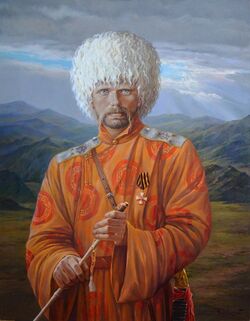
The conquests of Temrkai Khan turned him into a symbol of the modern Jelbic revival and traditionalist pan-Jelbism
The popular resentment against foreign and minority rule in the Jelbic world eventually led to a resurgence of pan-Jelbism, culminating in the Suadmjekestijogad (Jelbic Renaissance) of the 36th-39th centuries, which would have a long-lasting impact on Jelbic cultures and languages. Ironically the Suadmjekestijogad was initially sponsored by a non-Jelbic foreign power with the goal of expanding its rule over the Jelbic world. The Suadmjekestijogad was the result of Deltarian instrumentalization of Jelbic nationalistic sentiments with the end goal of incorporating pan-Jelbism under the roof of the Deltarian Empire, as Deltaria realized the potential of Jelbic nationalism for legitimizing its incorporation of Jelbic nations under its rule. The Deltarian-sponsored resurgence of Jelbic culture and identity was initiated with the Jelbanian-Deltarian War and the conquest of Jelbania, with the implementation of a traditionally Jelbic regime in the Empire's new province and the subsequent creation of the Jelbic Union of the North. The Barmenian annexation of Vanuku was recognized and legitimized, and under the umbrella of the Union of the North most of the Jelbosphere was brought under Deltarian rule. The Suadmjekestijogad outlived the Deltarian Empire, and was given a new impetus by the conquests of Temrkai Khan, culminating in the Jelbic Khaganate of 3777-3816. Although pan-Jelbism was largely discredited after the fall of the Khaganate, the Suadmjekestijogad had a profound and lasting impact on Jelbic culture. Its achievements include the revival of traditional Jelbic forms of political organization, the official recognition of bilingualism in Vanuku, enhanced inter-Jelbic cooperation, the resurgence of pre-Ahmadi and pre-Hosian Jelbic religious traditions, and partly successful attempts at narrowing the differences that had grown between the national varieties of Old High Jelbic in the millennium since the language was created. The Suadmjekestijogad differed substantially from the Nrljogad; whereas the latter was a form of secular modernizing nationalism, the former was characterized by traditionalism and the deliberate adoption of ancient Jelbic political models. Together the Nrljogad and the Suadmjekestijogad form the foundation of modern-day Jelbic identity and languages.
Religion[]
Ancient times[]
The ancient religious beliefs of the Jelbic peoples have been reconstructed based on written accounts from neighboring peoples, archaeological evidence, and contemporary folk practices of the Jelbic peoples. The religion and mythology of the ancient Jelbics were very similar to those of other Jelbo-Tukaric peoples, and show some overlap with the earliest recorded beliefs of the Gao-Showa people. The core element of ancient Jelbic religion is the belief in the Eternal Blue Sky (Tanhri), a quasi-monotheistic creator deity who rules the fate of the entire world and acts freely. Later on, after the settlement of Jelbo-Tukaric peoples in Majatra, Jelbic mythology was influenced by other local mythologies. For example, in Vanuku Jelbic and Selucian and Cildanian myths coexist, leading to the emergence of a syncretic religion known as Zollism. The heaviest ancient influence on Jelbic beliefs comes from Yazdism, which is believed to be the origin of Jelbic monotheism. It is also known that ancient Jelbics practiced shamanism, a tradition that continues to this day. Jelbic shamans were believed to be intermediaries between the human and divine worlds, and they were selected by fate; slight abnormalities at birth (caul, neonatal teeth, additional fingers, etc.) were believed to signify that the newborn was preordained to be a shaman. In addition to the creator deity Tanhri, ancient Jelbics had a rich mythology comprising numerous gods, demigods, and heroes. The wolf, falcon, deer, and horse were important symbolic animals.
Ahmadism[]
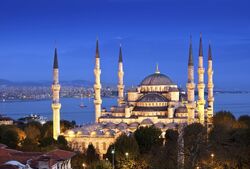
Caliph Azi Mosque in Barmenistan, showing elements of Augustan architecture
A slight majority of Jelbics are nominally followers of Ahmadism, a religion founded in the 12th century within the Jelbic world of the time. Under the Jelbic-ruled first Caliphate Ahmadism and Jelbic identity and languages were fused into a unique Jelbo-Ahmadi identity, to the point that the two have become indistinguishable to outsiders. However substantial numbers of Jelbics follow other religions, and even many of those who profess Ahmadism continue some of the folk practices associated with pre-Ahmadi religions. Ahmadism nonetheless remains the largest and most significant religious influence on all Jelbic peoples, and historically solidarity has been stronger between Jelbic Ahmadis than between all Ahmadis because of the widely shared belief that only Jelbic Ahmadis are true Ahmadis. Classical Brmek, a Jelbic language, remains one of the two liturgical languages of Ahmadism, and the wide geographic spread of Jelbic speakers is partly a result of the cultural and linguistic assimilation that occurred under the Ahmadi Caliphate. Most Jelbic Ahmadis belong to the Israi sect, sometimes (inaccurately) believed to be the Jelbic form of Ahmadism (as opposed to Majatran Abadism), however there are substantial numbers of Abadi, Sahabi, Halawi, and Zahiri Jelbics.
Hosianism[]
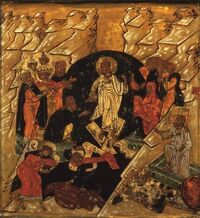
Terran Patriarchal icon from Vanuku, depicting Eliyahu's exile to Hell, cca. 24th century
Before the rise of Ahmadism several northern Jelbic tribes practiced various denominations of Hosianism. In Barmenistan and Pontesi Hosianism, particularly under its Osean form as well as under the Hobrazian Orthodox Church, had a prominent presence among several Jelbic communities. A large number of Jelbics later on converted to the Ancient Augustan Church as a result of the official adoption of that form of Hosianism by the Khanate of the Banster.
In the medieval era, following the conquest of large portions of the former Augustan and Tokundian Empires by the Ahmadi Caliphate, a large Hosian population was brought under Jelbic Ahmadi rule. Many of the Hosian communities that had been persecuted as heretical under the two empires initially welcomed Ahmadi conquest, and under the Caliphate Hosians of all denominations were protected and some enjoyed more religious freedom under Ahmadi dominance than they had under Augustan and Tokundian rule. Hosians under the Caliphate were however a frequent target for persecution and occasional instances of forced conversion, and they had to pay a protection tax in exchange for freedom of worship. Nonetheless Hosians in the Caliphate made significant contributions to the Jelbic-Ahmadi civilization, as many Jelbic Hosians were top poets, physicians, writers, or government officials. Additionally, with the gradual assimilation of the peoples under Caliphate rule into the Jelbic meta-ethnicity many indigenous Hosian communities adopted the Jelbic language, culture, and in some cases identity while retaining their pre-Ahmadi religions.
Today Jelbic Hosians belong to three main Hosian denominations. In Barmenistan and parts of Pontesi and Vanuku a plurality of Jelbic Hosians adhere to the Apostolic Church of the East, under the Barmenian Apostolic Church and the Hobrazian Orthodox Church. In Vanuku and Jelbania the largest Hosian denomination is the Terran Patriarchal Church, a consequence of the adoption of Augustan Hosianism as the official variety of the religion in those areas. In areas that were historically under Selucian influence, namely Pontesi and Barmenistan, the Aurorian Patriarchal Church retains a wide following among the Jelbic population. In addition to these three denominations many Jelbics practice other forms of Hosianism, such as Oseanism, Abjurantism, or Bishopalism.
Felinism[]
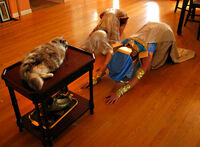
Barmenian Felinists from Pontesi
The interaction between the many faiths present in Barmenistan, including Selucian Hosianism, Selucian Paganism, Ahmadism, and Jelbic Shamanism, as well as the continued prevalence of pre-Jelbic myths and legends eventually led to the birth of a new idiosyncratic religion centered around the worship of cats as divine beings. Felinism was born in 30th century Barmenistan in the aftermath of Selucian rule in the nation, and was founded after the revelations received by Lady Ershébef Kepahisn, a Seluco-Barmenian aristocrat. Building on the ancient veneration of cats in Selucian and Cildanian mythology, where they were honored for their vermin-catching abilities, and including many elements of Jelbic, Selucian, and Cildanian myths, Felinism soon became the most widely followed religion in Barmenistan, often practiced in syncretism with several other faiths, including Hosianism and Ahmadism. Due to its unusual nature and its heavy Selucian influence, Felinism was often resented by Jelbic nationalists and was seen as an impediment to Jelbic unity. The nationalist and religious resentment against Felinism culminated in the Barmenian Refugee Crisis, whereby the practice of Felinism was outlawed in Barmenistan and Felinists were eventually expelled en masse from the nation. The Refugee Crisis also resulted in the incorporation of Felinism into Selucian Paganism, as well as the establishment of a significant Barmenian Felinist diaspora in neighboring countries. Although Felinism was largely eliminated from Barmenistan, the Felinist diaspora led to a wider geographic spread of the Jelbic language and culture.
Pagan revival[]
In modern times, particularly since the resurgence of traditional Jelbic culture during the Suadmjekestijogad, many Jelbics have turned to the traditional pre-Hosian and pre-Ahmadi religious beliefs and practices, collectively termed "Jelbic shamanism". The ancient rituals and mythologies of the Jelbic peoples were never fully abandoned, as they continued as folk beliefs and customs practiced by Jelbics even while adhering to monotheistic religions, but starting with the 35th century there has been renewed interest in Jelbic religious traditions as a rediscovery of the "authentic" religions of the Jelbic peoples. Shamans (Zsijokai) regained a prominent and sometimes even governmental role, Jelbic politicians have made numerous references to Tanhri and other Jelbic divinities, and Zollism has been reassessed as more a philosophical view and way of life, compatible with Hosianism or Ahmadism, rather than a polytheistic pagan religion. While the resurgence of Jelbic mythology and neo-Paganism has been seen positively by many Jelbic nationalists, there have also been numerous instances of occasionally violent conflict with Ahmadi and Hosian clergy, displeased with what they perceive as the re-Paganization of the Jelbic peoples. It is also important to note that while the modern-day Pagan revival makes use of ancient symbols and rituals, it is for all intents and purposes a modern religious movement, including many invented traditions as well as frequent use of language, organization, or rites typical of the more established Ahmadi and Hosian religions. Nonetheless, while a small minority of Jelbic peoples declare their adherence to Tanhrism or Zollism, Jelbic folk practices are widespread throughout the Jelbosphere.
Language[]
Jelbics natively speak a number of languages, collectively known as the Jelbic languages, belonging to the Jelbo-Tukaric family, one of Terra's primary language families. Jelbic languages diverge significantly from other Jelbo-Tukaric languages, although they share numerous common elements, among which an agglutinative grammar, a subject–object–verb word order, a lack of noun classes and grammatical gender, and most core vocabulary. The most widely used and most prestigious Jelbic language is Old High Jelbic, a pluricentric and formal language created in the 23rd century by modernizing and purifying Classical Brmek. The latter had been the only written Jelbic language of the Jelbosphere and the language of culture and religion from the 14th century onwards, although spoken Jelbic had begun to diverge from the Classical standard by the 17th century, and by the 18th century Classical Brmek became extinct as a spoken language. The Nrljogad was an attempt at producing a modern standardized variety of spoken Jelbic that could be understood by the majority of Jelbics. Language reformers in the 23rd century thus purged Classical Brmek of Aldegarian and Kathuran loanwords replacing them with Jelbic equivalents newly derived from Jelbic roots, as well as revived Old Jelbic words and in some cases Jelbo-Tukaric cognates that had not been used for centuries. Moreover, since the spoken Jelbic had lost nearly all inflection by the 23rd century, language planners removed case and verb endings, which by that point were omitted even in formal Classical Brmek writing. Pronunciation too had changed drastically since medieval times, and the standardized Jelbic language took this into account by basing its pronunciation on Jelbic spoken by nomadic Jelbics from Jelbania, which language planners saw as the "purest" form of Jelbic, as it had a comparably smaller foreign influence.
The creation of Old High Jelbic was overall a great success, as the language created in the 23rd century remains the most widely used and generally only written form of Jelbic and the lingua franca of the entire Jelbosphere. However the end goal of introducing a single pan-Jelbic literary standard was never achieved, for two main reasons. Firstly, due to the lack of a single regulatory organization that would maintain unity in the language, Old High Jelbic became a pluricentric language, with four formalized standard forms (namely Jelbek, Brmek, Pntek, and Wrnukaek) that although differ slightly, use different official scripts and source languages for loan-words. The second reason for the relative failure of Old High Jelbic becoming the only spoken language in the Jelbosphere is natural language evolution in the Jelbic world. Today's Jelbics speak a number of languages and dialects that differ significantly both from each other and from Old High Jelbic, and although most literate Jelbics are fluent in Old High Jelbic in one of its four standard forms, the native languages of the Jelbic peoples are substantially different from the exclusively formal Old High Jelbic. Some of these vernacular Jelbic languages, most notably Banmek and Jelbido, have been elevated to the status of literary languages, however they are largely eclipsed by the far more prestigious Old High Jelbic and their use in writing is declining.
In order to bridge the gap between the national varieties of Old High Jelbic the Jelbic Language Academy was founded in 3932 as a non-profit educational institution, with the goal of maintaining a standard grammar and pronunciation for the language, standardizing vocabulary, and creating new words (almost exclusively derived from existing Old High Jelbic roots). In spite of its prescriptive character, the Academy continues to recognize the rights of Jelbic nations to develop new vocabulary and supports the evolution of the national varieties of the language.
